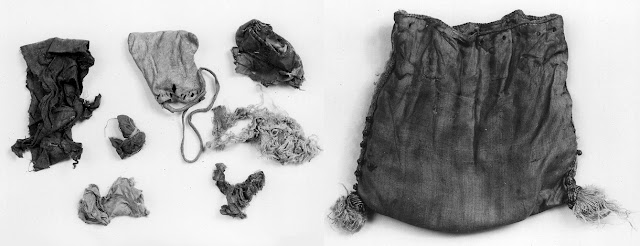The kind of medieval pouches shown in a previous blogpost, as well as those described in the catalogue of medieval textiles from the treasury of the St. Servatius church in Maastricht, the Netherlands (see photo below) did inspire Anne to make some pouches as well.
A 14th century pouch made from four pieces of Italian lampas silk (red/green/white with gold threads) with red pompoms. The pouch was made from four downward tapered segments, of which two were cut out from the same repeated pattern (birds and other animals). The leather lining is connected to the outer fabric with the seam covered with a green braid. The attachment and closing cord of the bag is also made of a green braid. The pompoms are attached to the side and bottom of the pouch. 16 cm height, 18 cm width. Image from the book Mittelalterlichen Textilien von St. Servatius in Maastricht by A. Stauffer.
Anne's version of this pouch is smaller (7 cm height, 8 cm wide) and made of embroidered silk. Blue silken pompoms are attached at the four corners, as well as at the drawstrings. The inside is made of a cream-coloured silk. We would like to place some remains of St. Thomas (or fragments of his clothes) inside the pouch, like that of the reliquary pouch from Maaseik (Belgium), but have not found some yet. Early next year, Anne will visit India and perhaps she can locate a something of him (for instance, a brick from the palace that St. Thomas built or a tooth from the dog who brought the hand of the cup-bearer that offended St. Thomas at the wedding feast).

Different views of Anne's pompom pouch.
Six
textile fragments and a small leather purse: the contents of a
reliquary pouch from the shrine of Johannes Nepomucenus from the St.
Catharina church in Maaseik, Belgium. The pouch (right) and fragments
(left) are dated between 1200 and 1400. The pouch itself is made of silk
and measures 11 cm (height) by 9 cm (width). At the sides are small
metal beads or pearls. Photos from KIK IRPA, Brussels, Belgium.
Another small purse (also 7 cm height by 8 cm wide) that Anne made of some leftover red silk with a cream-coloured pattern. The inside is the same cream silk as the pompom pouch. The drawstring consists of two colours of silken embroidery thread, and made as medieval rope (but using a cordless power drill to speed up the process).
Anne's second pouch. you can clearly see the holes at the top of the pouch through which the drawstring goes.
The pouch closes by pulling the string simultaneously at the opposite sides.
The
Maastricht brickstitch pouch with silk stitching on linen ground. Yarn
colours are red (now beige), bright blue and gold-plated silver. Inside
of the pouch is red taftsilk. Height 9 cm, width 14 cm. Image from the book Mittelalterlichen Textilien von St. Servatius in Maastricht by A. Stauffer.
The following green and red pouch is based on the brickstitch pattern that is found on a reliquary pouch (dated around 1300) in the Maastricht treasury. A handout of this pattern (used to embroider the pouch) can be found at the excellent Medieval Silkwork blog. This pouch has been Anne's first attempt at brickstitch embroidery. The pouch measures 10 by 13 cm, while the actual brickstitch area is (twice) 10 by 10 cm. The inside and the border are made of red silk. The pouch closes with a two-coloured drawstring, made the same way as described above. The pouch now holds a collection of embroidery yarn and utensils. An interesting post on medieval embroidery yarn and the modern equivalents is also found at the Medieval Silkwork blog.
Anne's version of the Maastricht brickstitch pattern pouch. Both sides are embroidered with the brickstitch pattern.
































































